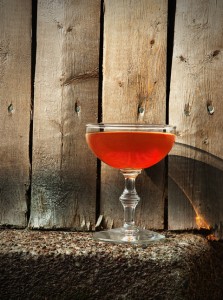Rule 37. Try one new drink each week.
The Rule 37 series of posts chronicle my attempts to accomplish this feat every week.
For the recipes of R37s past, click the Htf do I make these drinks? tab.
Not that I base my cocktail drinking solely on the weather, but it certainly does make an impact. After last week’s 80 degree sunshine, this weekend was a bit more brisk, with temps in the 50s. In other words, proper springtime weather. You didn’t NEED a jacket, but also wouldn’t mind having one along.
As it happened, I read this post from the wondrous blog 12 Bottle Bar earlier in the week. Sidebar: go check out that blog. It’s a wonderfully written and photographed series of articles all pertaining to the self-imposed limit of having only twelve bottles (including bitters!) in a home bar. While I have been busy trying to purchase one of EVERYTHING, 12 Bottle Bar shows the incredible range of cocktails possible with very carefully chosen ingredients. It’s like painting with a selective palette. The Affinity cocktail described seemed tasty, so I put it on my list to try in the future. Well, I didn’t wait too long, so here it is.
So this week’s Rule 37 is a bit less summery, and a bit more savory. The spirit here is Scotch, and if you’re going to use a Scotch, it may as well be a proper one. Having far too many to choose from, after a long, long, look at the bar, I went with Ardbeg 10 year old, an Islay single malt. It’s a big boy. Let’s peat this mother up. I have yet to procure any high-end vermouth, so Martini & Rossi’s bottlings of both Italian/sweet and French/dry vermouths would have to suffice.
 The Affinity
The Affinity
– 3/4 oz Scotch Whisky (Ardbeg 10yo)
– 3/4 oz sweet vermouth
– 3/4 oz dry vermouth
– Two dashes Angostura Bitters
Add ice to a mixing glass and pour in the ingredients. STIR for at least 30 seconds. Proper stirring should take a little longer than shaking, but since this is a spirit-only cocktail (no fruit juice) it should be stirred, like a Manhattan or Martini, to keep the drink crystal clear.
Well, I can tell without getting anywhere near this drink that it’s got a Big Scotch in it. The Ardbeg commands attention even at arm’s length. Upon closer exploration of the bouquet, there is a lot more going on under the surface than initially suspected. The aromatic wines add both a dark syrup fruit, and lightly sharpened crispness to the aroma. These were both newly-opened bottles of vermouth, so they should be at their best, as vermouth does spoil once opened. I can’t help but feel there should be a cherry lounging at the bottom of the coupe, but for now we’ll keep it simple.
The taste is, at once, much less formidable than the powerful smoked peat vapors would have you believe. It starts with a syrupy tang of sour fruit, mingling with the background static of the Scotch demanding attention. Surprisingly, the 2:1 ration of vermouth to Scotch forces the old grouch to settle down and await his turn. In the middle, he makes his move, but not before a clove spice from the Angostura is detected. In fact the Angostura is quite prevalent in the middle ground, before all are washed away in a smokey bitter wash. It’s a sweet candy eaten next to a campfire. The flavor lingers in your mouth as syrupy sweet wine, but with a burnt charcoal. A tingle on my gums where the Scotch has washed over leads me to check the bottle, and confirm that the whisky is indeed a higher proof variety at 96°, 46% abv.
Yes, the ingredients are similar to a Perfect Manhattan or, given the use of Scotch, a Perfect Rob Roy, but with equal parts spirit and vermouths, it is entirely transformed. Other variations increase the ratio of spirit-to-vermouth, but I’d leave it alone at equal parts. Orange bitters was another common substitution I saw, but again, I’ll stick with the Angostura as directed. Perhaps with a different whisky, the orange bitters would work, but I think the super-smokey Ardbeg is complimented with hints of cinnamon and spices in the Angostura.
The Cold Glass blog describes this as a candidate for “Scotch Cocktail For People Who Don’t Like Scotch,” and I couldn’t put it better. With a more approachable whisky, like The Macallan or Glenmorangie, it would be a perfect starter Scotch-tail. Hell, go with a nice blend like Johnny Walker Black Label if you don’t want to use up your single malts for mixing. For those who enjoy the big guns, I could see this working with just about any other whisky, from Laphroig’s peat to Bowmore’s salt to Dalmore’s leather. A word of caution: while I suspect this could also work with a non-peated whiskey (rye, bourbon, Irish, etc) I’m not convinced that they’d stand up to the double-hit of sweet and dry vermouth. I would recommend playing with the proportions and creating a new variation. I might go with equal parts whiskey to vermouth (total), say, 1 1/2 oz whiskey, 3/4 oz sweet and 3/4 oz dry vermouth. The Angostura, or any other spiced bitter, is the right choice for this, though if you must add orange, add it alongside the Angostura, not as a replacement.
This is simply wonderful. The vermouths put the whisky in his place, but the fire and brimstone is still there, just much subdued. Exquisitely balanced, and very flavorful. It needs nothing more.